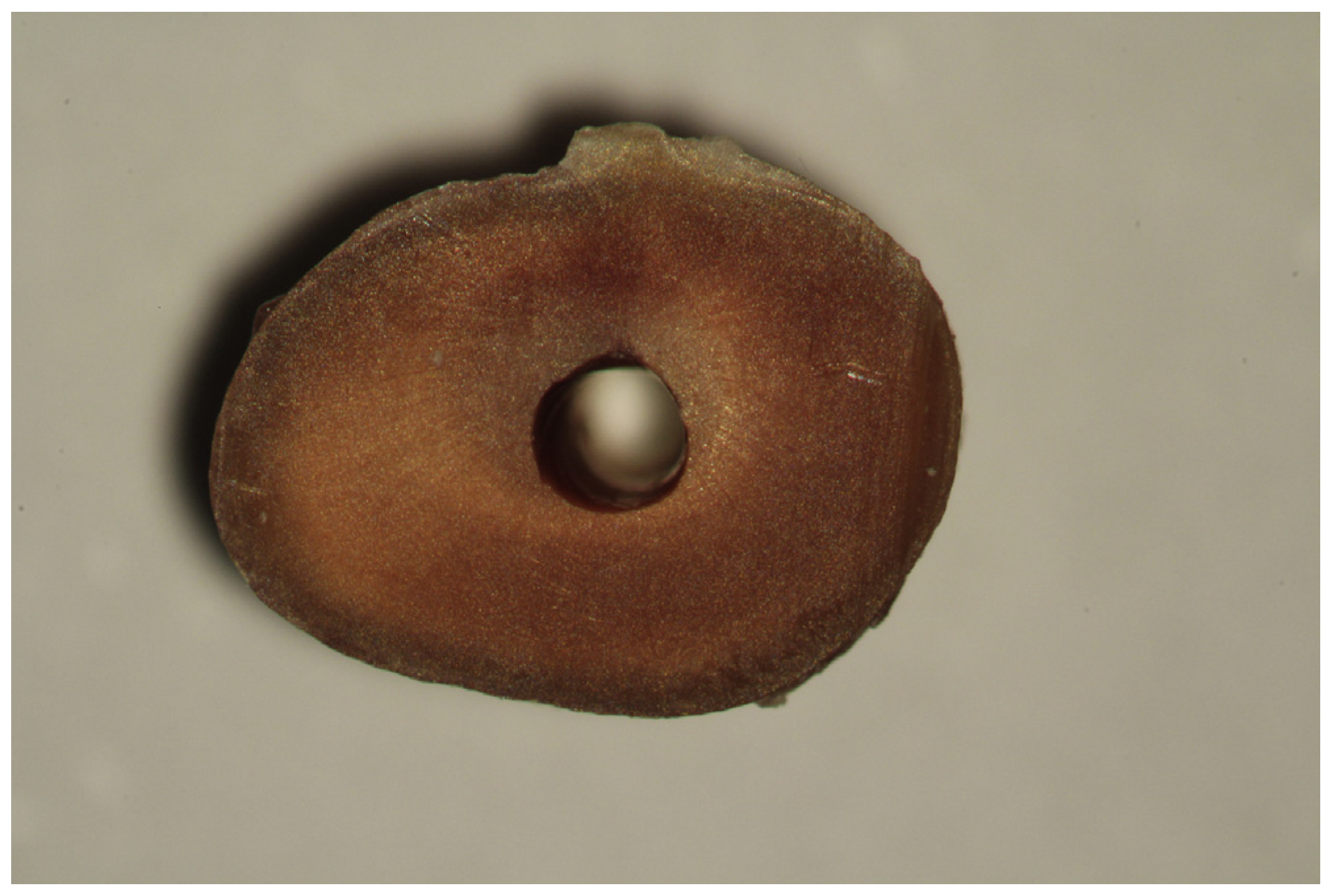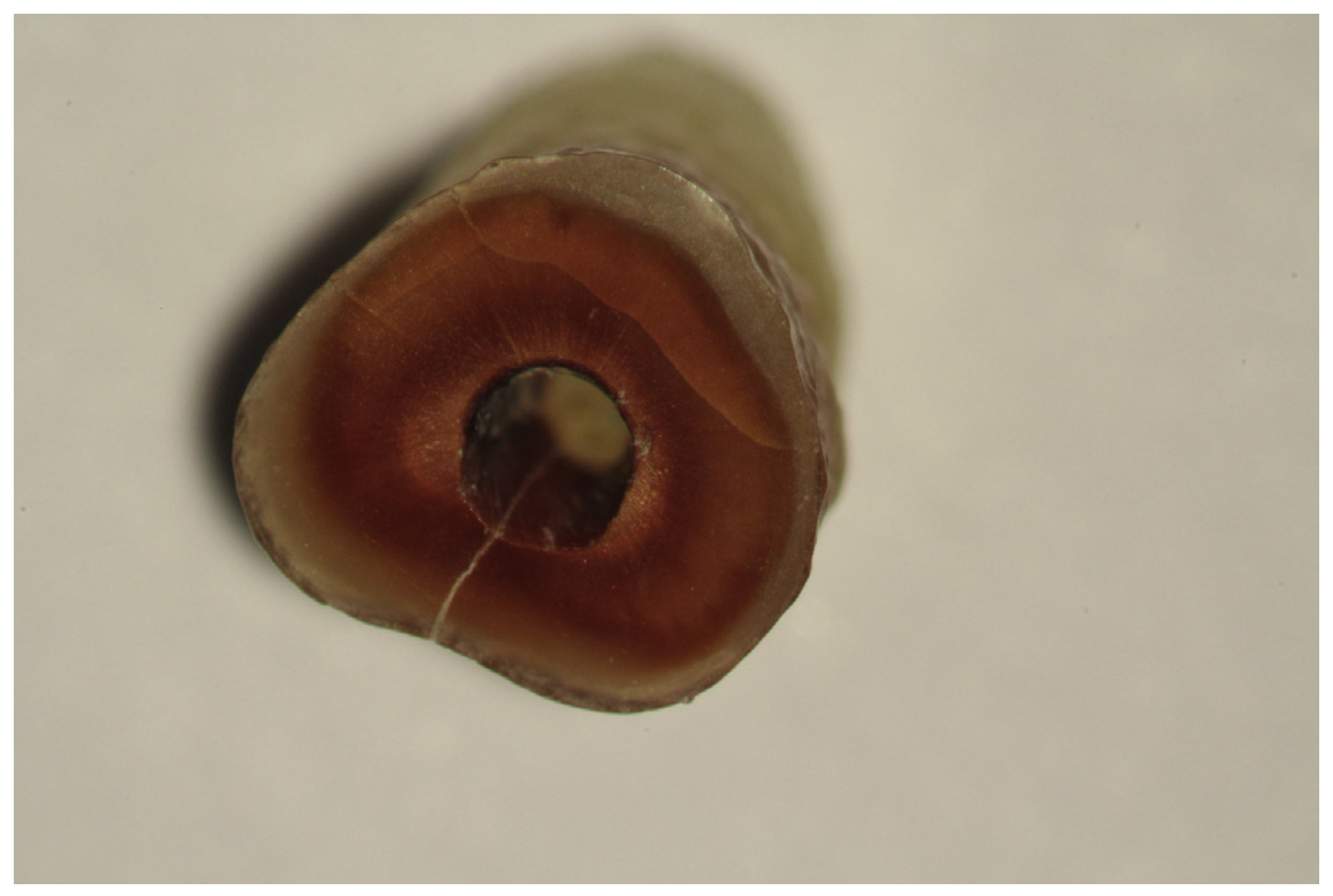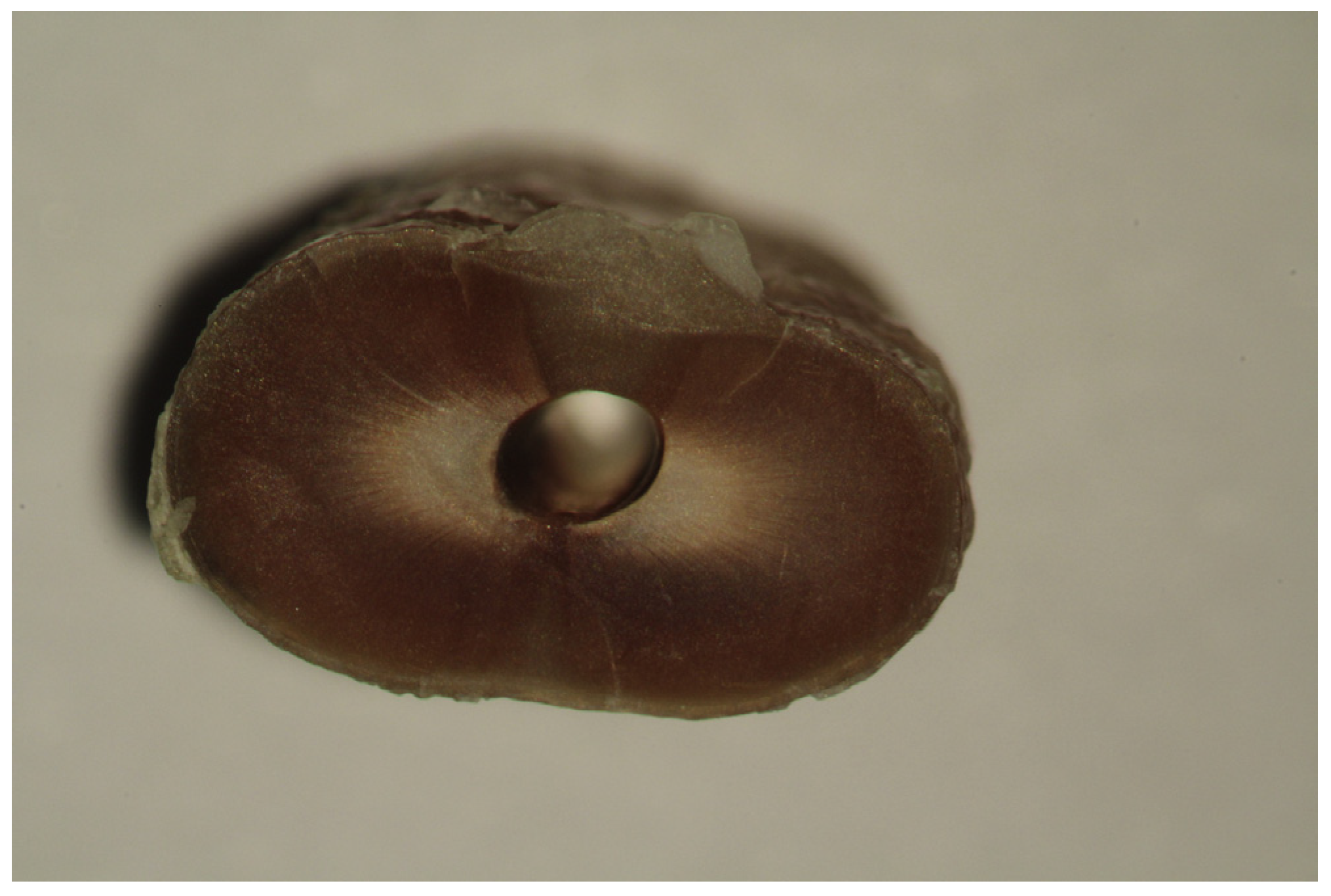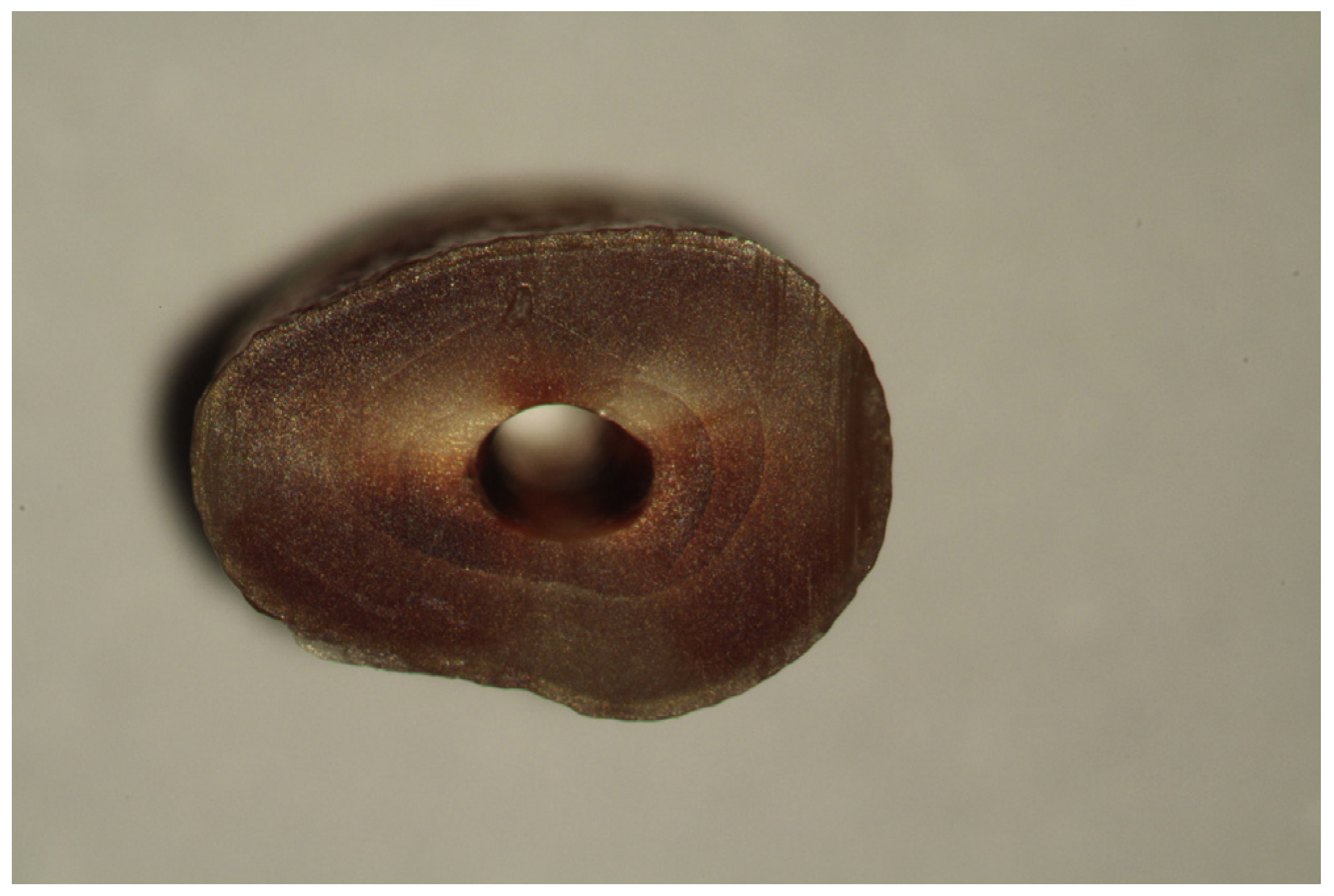Potential to induce dentinal cracks during retreatment procedures of teeth treated with ‘‘Russian red’’: An ex vivo study
Abstract
1. Introduction
2. Materials and methods
2.1. Preparation of specimens
2.2. Preparation of specimens (Groups 1 and 2)
2.3. Evaluation of specimens
2.4. Classification of dentin defects
2.5. Statistical analysis
3. Results
3.1. Bivariate comparisons
3.2. Crack identification – aid of magnification
3.3. Dentin cracks in different root locations
3.4. The influence in methylene dye in aiding crack identification
4. Discussion
5. Conclusions
Conflicts of Interest
Acknowledgments
R E F E R E N C E S
- Sim, TP; Knowles, JC; Ng, YL; Shelton, J; Gulabivala, K. Effect of sodium hypochlorite on mechanical properties of dentine and tooth surface strain. Int Endod J 2001, 34, 120–32. [Google Scholar] [CrossRef] [PubMed]
- Doyon, GE; Dumsha, T; Fraunhofer, JA. Fracture resistance of human root dentin exposed to intracanal calcium hydroxide. J Endod 2005, 31, 895–7. [Google Scholar] [CrossRef] [PubMed]
- Shemesh, H; Bier, CA; Wu, MK; Tanomaru-Filho, M; Wesselink, PR. The effects of canal preparation and filling on the incidence of dentinal defects. Int Endod J 2009, 42, 208–13. [Google Scholar] [CrossRef] [PubMed]
- Kishen, A. Mechanism and risk factors for fracture predilection in endodontically treated teeth. Endod Top 2006, 13, 57–83. [Google Scholar] [CrossRef]
- Schwandt, NW; Gound, G. Resorcinol–formaldehyde resin “Russian red” endodontic therapy. J Endod 2003, 29, 435–7. [Google Scholar] [CrossRef] [PubMed]
- Matthews, JD. Pink teeth resulting from Russian endodontic therapy. J Am Dent Assoc 2000, 131, 1598–9. [Google Scholar] [CrossRef] [PubMed]
- Gluskin, AH. Mishapes and serious complications in endodontic obturation. Endod Top 2005, 12, 52–70. [Google Scholar] [CrossRef]
- Medical Device Directive 93/42 EEC.
- Quality guidelines for endodontic treatment: consensus report of the European Society of Endodontology. Int Endod 2006, 39, 921–30.
- Hensten, A; Jacobsen, N. Allergic reactions in endodontic practice. Endod Top 2005, 12, 44–51. [Google Scholar] [CrossRef]
- Ongenae, K; Matthieu, L; Constandt, L; Van Hecke, E. Contact allergy to resorcinol monobenzonate. Dermatology 1998, 196, 470–3. [Google Scholar] [CrossRef] [PubMed]
- Gound, TG; Marx, D; Schwandt, NA. Incidence of flare-ups and evaluation of quality after retreatment of resorcinol–formaldehyde resin (“Russian Red Cement”) endodontic therapy. J Endod 2003, 29, 624–6. [Google Scholar] [CrossRef] [PubMed][Green Version]
- Wu, MK; Wang, M. Clinical and experimental observation on resinifying therapy. Oral Surg Oral Med Oral Pathol 1986, 62, 441–8. [Google Scholar] [CrossRef]
- Gambrel, MG; Hartwell, GR; Moon, PC; Cardon, JW. The effect of endodontic solutions on resorcinol–formalin paste in teeth. J Endod 2005, 31, 25–9. [Google Scholar] [CrossRef] [PubMed]
- Gulabivala, K; Patel, B; Evans, G; Yuan-Ling, NG. Effect of mechanical and chemical procedures on root canal surfaces. Endod Top 2005, 10, 103–22. [Google Scholar] [CrossRef]
- Okitsu, M; Takahashi, H; Yoshioka, T; Ivasaki, N; Suda, H. Effective factor including periodontal ligament on vertical root fractures. J Endod 2005, 20, 32–7. [Google Scholar] [CrossRef]
- Soros, C; Zinelis, S; Lambrianidis, T; Palaghias, G. Spreader load required for vertical root fracture during lateral compaction ex vivo: evaluation of periodontal simulation and fracture load information. Oral Surg Oral Med Oral Pathol Oral Radiol Endod 2008, 106, e64–70. [Google Scholar] [CrossRef] [PubMed]
- Burklein, S; Tsotsis, P; Schafer, E. Incidence of dentinal defects after root canal preparation: reciprocating versus rotary instrumentation. J Endod 2013, 39, 501–4. [Google Scholar] [CrossRef] [PubMed]
- Adorno, CG; Yoshioka, T; Suda, H. The effect of root preparation technique and instrumentation length on the development of apical root cracks. J Endod 2009, 35(3), 389–92. [Google Scholar] [CrossRef] [PubMed]
- Nazari, A; Bajaj, D; Zhang, D; Romberg, E; Arola, D. Aging and the reduction in fracture toughness of human dentin. J Mech Behav Biomed Mater 2009, 2, 550–9. [Google Scholar] [CrossRef] [PubMed]
- Barreto, MS; Moraes Rdo, A; Rosa, RA; Moreira, CH; Só, MV; Bier, CA. Vertical root fracture and dentin defects: effects of root canal preparation, filling and mechanical cycling. J Endod 2012, 38, 1135–9. [Google Scholar] [CrossRef] [PubMed]
- Zandbiglari, T; Davids, H; Schafer, E. Influence of instrument taper on the resistance to fracture of endodontically treated roots. Oral Surg Oral Med Oral Pathol Oral Radiol Endod 2006, 101, 126–31. [Google Scholar] [CrossRef] [PubMed]
- Bergmans, L; Van Cleynenbreugel, J; Beullens, M; Wevers, M; Van Meerbeek, B; Lambrechts, P. Smooth flexible versus active tapered shaft design using NiTi rotary instruments. Int Endod J 2002, 35, 820–8. [Google Scholar] [CrossRef] [PubMed]
- Wilcox, LR; Roskelley, C; Sutton, T. The relationship of root canal enlargement to finger-spreader induced vertical root fracture. J Endod 1997, 23, 533–4. [Google Scholar] [CrossRef]
- Sedgley, CM; Messer, HH. Are endodontically treated teeth more brittle? J Endod 1992, 18, 332–5. [Google Scholar] [CrossRef]
- Kivan, BH; Alacam, T; Ulusoy, OI; Genc, O; Gorgul, G. Fracture resistance of thin-walled roots restored with different post systems. Int Endod J 2009, 42, 997–1003. [Google Scholar] [CrossRef] [PubMed]
- Bier, CAS; Shemesh, H; Tanomaru-Filho, M; Wesselink, PR; Wu, M-K. The ability of different nickel-titanium rotary instrument to induce dentinal damage during canal preparation. J Endod 2009, 35, 236–8. [Google Scholar] [CrossRef] [PubMed]
- Liu, R; Kaiwar, A; Shemesh, H; Wesselink, PR; Hou, B; Wu, MK. Incidence of apical root cracks and apical dentinal detachments after canal preparation with hand and rotary files at different instrumentation length. J Endod 2013, 39, 129–32. [Google Scholar] [CrossRef] [PubMed]
- Kim, HC; Lee, MH; Yum, J; Versluis, A; Lee, CJ; Kim, BM. Potential relationship between design of nickel-titanium rotary instruments and vertical root fracture. J Endod 2010, 36, 1195–9. [Google Scholar] [CrossRef] [PubMed]
- Shemesh, H; Alida, C; Roeleveld; Paul, R; Wesselink; Min-Kai, Wu. Damage to root dentin during retreatment procedures. JOE 2011, 37, 63–6. [Google Scholar] [CrossRef] [PubMed]
- Stock, CJ. Current status of the use of ultrasound in endodontics. Int Dent J 1991, 41, 175–82. [Google Scholar] [PubMed]
- Navarre, SW; Steiman, HR. Root-end fracture during retropreparation: a comparison between zirconium nitride-coated and stainless steel microsurgical ultrasonic instruments. J Endod 2002, 28, 330–2. [Google Scholar] [CrossRef] [PubMed]
- Wright, HM, Jr.; Loushine, RJ; Weller, RN; Kimbrough, WF; Waller, J; Pashley, DH. Identification of resected root-end dentinal cracks: a comparative study of transillumination and dyes. J Endod 2004, 30, 712–5. [Google Scholar] [CrossRef] [PubMed]
- Von Arx, T; Kunz, R; Schneider, AC; Burgin, W; Lussi, A. Detection of dentinal cracks after root-end resection: an ex vivo study comparing microscopy and endoscopy with scanning electron microscopy. J Endod 2010, 36, 1563–8. [Google Scholar] [CrossRef] [PubMed]
- Thaler, A; Ebert, J; Petschelt, A; Pelka, M. Influence of tooth age and root section on root dentin dye penetration. Int Endod J 2008, 41, 1115–22. [Google Scholar] [CrossRef] [PubMed]




| Any root fractures | Magnification ×10 | Magnification ×16 | ||||||
|---|---|---|---|---|---|---|---|---|
| No | Yes | P | No | Yes | P | |||
| ProTaper | Coronal | Without Methylene | 32 (80.0) | 8 (20.0) | 0.008 | 35 (87.5) | 5 (12.5) | <0.001 |
| With Methylene | 25 (62.5) | 15 (37.5) | 24 (60.0) | 16 (40.0) | ||||
| Apical | Without Methylene | 40 (100.0) | 0 (0.0) | 1.000 | 40 (100.0) | 0 (0.0) | 0.314 | |
| With Methylene | 40 (100.0) | 0 (0.0) | 39 (97.5) | 1 (2.5) | ||||
| Comparisons | ProTaper: Coronal vs. Apical: | ProTaper: Coronal vs. Apical: | ||||||
| w/o Methylene (P = 0.003) | w/o Methylene (P = 0.021) | |||||||
| with Methylene (P < 0.001) | with Methylene (P = <0.001) | |||||||
| ProTaper + Ultrasound | Coronal | Without Methylene | 21 (52.5) | 19 (47.5) | 0.655 | 20 (50.0) | 20 (50.0) | 0.654 |
| With Methylene | 19 (47.5) | 21 (52.5) | 18 (45.0) | 22 (55.0) | ||||
| Apical | Without Methylene | 37 (92.5) | 3 (7.5) | 0.456 | 39 (97.5) | 1 (2.5) | 0.025 | |
| With Methylene | 35 (87.5) | 5 (12.5) | 33 (82.5) | 7 (17.5) | ||||
| Comparisons | ProTaper + Ultrasound: | ProTaper + Ultrasound: | ||||||
| Coronal vs. Apical | Coronal vs. Apical | |||||||
| w/o Methylene (P < 0.001) | w/o Methylene (P < 0.001) | |||||||
| with Methylene (P < 0.001) | with Methylene (P = 0.001) | |||||||
| ProTaper vs. ProTaper + Ultrasound | ProTaper vs. ProTaper + Ultrasound | |||||||
| Coronal: w/o Methylene (P = 0.009) | Coronal: w/o Methylene (P < 0.001) | |||||||
| with Methylene (P = 0.178) | with Methylene (P = 0.179) | |||||||
| Apical: w/o Methylene (P = 0.078) | Apical: w/o Methylene (P = 0.315) | |||||||
| with Methylene (P = 0.021) | with Methylene (P = 0.025) | |||||||
| Values are number (percentage). Chi-square test or Fisher exact test. | ||||||||
| Fracture type | Magnification ×10 | Magnification ×16 | ||||||
|---|---|---|---|---|---|---|---|---|
| ProTaper | ProTaper + Ultrasound | P | ProTaper | ProTaper + Ultrasound | P | |||
| Complete | Without Methylene | No | 39 (58.2) | 28 (41.8) | 0.001 | 40 (58.8) | 28 (41.2) | <0.001 |
| Yes | 1 (7.7) | 12 (92.3) | 0 (0.0) | 12 (100.0) | ||||
| With Methylene | No | 35 (57.4) | 26 (42.6) | 0.020 | 35 (58.3) | 25 (41.7) | 0.010 | |
| Yes | 5 (26.3) | 14 (73.7) | 5 (25.0) | 15 (75.0) | ||||
| P, with vs. without | 0.090 | 0.633 | 0.021 | 0.478 | ||||
| methylene | ||||||||
| Intradental | Without Methylene | No | 40 (58.8) | 28 (41.2) | <0.001 | 40 (61.5) | 25 (38.5) | <0.001 |
| Yes | 0 (0.0) | 12 (100.0) | 0 (0.0) | 15 (100.0) | ||||
| With Methylene | No | 40 (55.6) | 32 (44.4) | 0.003 | 40 (60.6) | 26 (39.4) | <0.001 | |
| Yes | 0 (0.0) | 8 (100.0) | 0 (0.0) | 14 (100.0) | ||||
| P, with vs. without | 1.000 | 0.302 | 1.000 | 0.816 | ||||
| methylene | ||||||||
| Incomplete from | Without Methylene | No | 35 (54.7) | 29 (45.3) | 0.093 | 38 (55.9) | 30 (44.1) | 0.012 |
| the outer root | Yes | 5 (31.3) | 11 (68.8) | 2 (16.7) | 10 (83.3) | |||
| surface | With Methylene | No | 30 (54.5) | 25 (45.5) | 0.228 | 32 (55.2) | 26 (44.8) | 0.133 |
| Yes | 10 (40.0) | 15 (60.0) | 8 (36.4) | 14 (63.6) | ||||
| P, with vs. without | 0.152 | 0.340 | 0.043 | 0.329 | ||||
| methylene | ||||||||
| Incomplete from | Without Methylene | No | 38 (53.5) | 33 (46.5) | 0.077 | 37 (50.7) | 36 (49.3) | 0.692 |
| the root canal | Yes | 2 (22.2) | 7 (77.8) | 3 (42.9) | 4 (57.1) | |||
| With Methylene | No | 37 (52.9) | 33 (47.1) | 0.176 | 33 (49.3) | 34 (50.7) | 0.762 | |
| Yes | 3 (30.0) | 7 (70.0) | 7 (53.8) | 6 (46.2) | ||||
| P, with vs. without | 0.064 | 1.000 | 1.000 | 0.500 | ||||
| methylene | ||||||||
| Values are number (percentage). Chi-square test or Fisher exact test. | ||||||||
| ProTaper vs. ProTaper + Ultrasound Location: Root’s Coronal Third | Magnification ×10 | Magnification ×6 | |||
|---|---|---|---|---|---|
| RR (95% CI) | P | RR (95% CI) | P | ||
| Complete fractures | Without Methylene | 0.1 (0.0; 0.6) | 0.033 | 0.1 (0.0; 0.6) | <0.001 |
| With Methylene | 0.2 (0.1; 0.5) | 0.011 | 0.3 (0.1; 0.8) | 0.009 | |
| Incomplete fractures from the outer root surface | Without Methylene | 0.5 (0.2; 1.2) | 0.081 | 0.2 (0.1; 0.9) | 0.018 |
| With Methylene | 0.7 (0.3; 1.3) | 0.167 | 0.6 (0.3; 1.2) | 0.105 | |
| Incomplete fractures from the root canal | Without Methylene | 0.3 (0.1; 1.3) | 0.077 | 0.8 (0.2; 3.1) | 0.499 |
| With Methylene | 0.4 (0.1; 1.5) | 0.155 | 1.2 (0.4; 3.2) | 0.500 | |
| RR, risk ratio. Chi-square test or Fisher exact test. | |||||
© 2017 The Lithuanian University of Health Sciences. Production and hosting by Elsevier Sp. z o.o. This is an open access article under the CC BY-NC-ND license (http://creativecommons.org/licenses/by-nc-nd/4.0/). (http://creativecommons.org/licenses/by-nc-nd/4.0/).
Share and Cite
Nedzinskienė, E.; Pečiulienė, V.; Aleksejūnienė, J.; Manelienė, R.; Drukteinis, S.; Jakaitienė, A. Potential to induce dentinal cracks during retreatment procedures of teeth treated with ‘‘Russian red’’: An ex vivo study. Medicina 2017, 53, 166-172. https://doi.org/10.1016/j.medici.2017.05.005
Nedzinskienė E, Pečiulienė V, Aleksejūnienė J, Manelienė R, Drukteinis S, Jakaitienė A. Potential to induce dentinal cracks during retreatment procedures of teeth treated with ‘‘Russian red’’: An ex vivo study. Medicina. 2017; 53(3):166-172. https://doi.org/10.1016/j.medici.2017.05.005
Chicago/Turabian StyleNedzinskienė, Eglė, Vytautė Pečiulienė, Jolanta Aleksejūnienė, Rasmutė Manelienė, Saulius Drukteinis, and Audronė Jakaitienė. 2017. "Potential to induce dentinal cracks during retreatment procedures of teeth treated with ‘‘Russian red’’: An ex vivo study" Medicina 53, no. 3: 166-172. https://doi.org/10.1016/j.medici.2017.05.005
APA StyleNedzinskienė, E., Pečiulienė, V., Aleksejūnienė, J., Manelienė, R., Drukteinis, S., & Jakaitienė, A. (2017). Potential to induce dentinal cracks during retreatment procedures of teeth treated with ‘‘Russian red’’: An ex vivo study. Medicina, 53(3), 166-172. https://doi.org/10.1016/j.medici.2017.05.005




